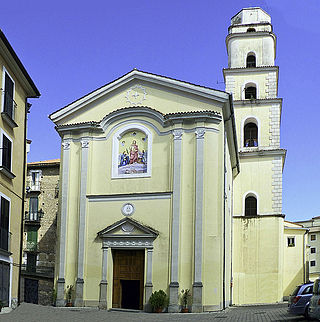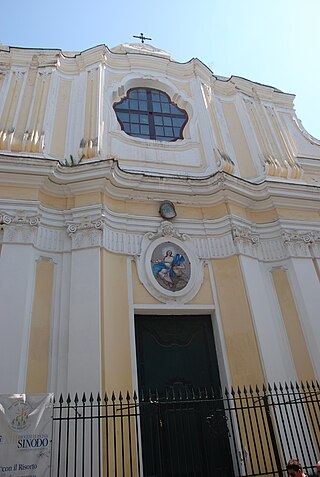
The Patriarchate of Venice, also sometimes called the Archdiocese of Venice, is a Latin Church ecclesiastical territory or patriarchal archdiocese of the Catholic Church in Venice, Italy. In 1451 the Patriarchate of Grado was merged with the Bishopric of Castello and Venice to form the Archdiocese of Venice.

San Giorgio in Velabro is a church in Rome, Italy, dedicated to St. George.

The diocese of Auxerre is a former French Roman Catholic diocese. Its historical episcopal see was in the city of Auxerre in Burgundy, now part of eastern France. Currently the non-metropolitan Archbishop of Sens, ordinary of the diocese of Sens and Auxerre, resides in Auxerre.

The Archdiocese of Amalfi-Cava de' Tirreni is an archdiocese of the Latin Church of the Catholic Church, with its episcopal see at Amalfi, not far from Naples. It was named Archdiocese of Amalfi until parts of the Diocese of Cava e Sarno were merged with it on September 30, 1986.

The Diocese of Vallo della Lucania is a Latin Church diocese of the Catholic Church in Campania, has existed under this name since 1945. It is a suffragan of the Archdiocese of Salerno-Campagna-Acerno.

The Diocese of Chartres is a Latin Church ecclesiastical territory or diocese of the Catholic Church in France.

The former Catholic diocese of Mirepoix, in south-west France, was created in 1317 by Pope John XXII from the diocese of Pamiers. It existed until the French Revolution, and was suffragan of the Archbishop of Toulouse. Its see was Mirepoix, Ariège.

The former French Catholic diocese of Rieux existed from 1317 until the French Revolution. It was based at Rieux-Volvestre, south-west France, in the modern department of Haute-Garonne.

The Diocese of Nocera Umbra was a Catholic diocese in Umbria, Italy.

The Diocese of Mazara del Vallo is a Latin diocese of the Catholic Church in far western Sicily. It is a suffragan of the Archdiocese of Palermo.

The Diocese of Tivoli is a Latin Church ecclesiastical territory or diocese of the Catholic Church in Latium, Italy, which has existed since the 2nd century. In 2002 territory was added to it from the Territorial Abbey of Subiaco. The diocese is immediately exempt to the Holy See.
The Italian Catholic diocese of Bertinoro existed from 1360 to 1986. In that year it was merged with the diocese of Forlì to create the diocese of Forlì-Bertinoro.

The Diocese of Conversano-Monopoli is a Latin diocese of the Catholic Church in Apulia. It has existed since 1986, when the diocese of Monopoli was united with the historic diocese of Conversano. The diocese is a suffragan of the Archdiocese of Bari-Bitonto.

The Diocese of San Severo is a Latin diocese of the Catholic Church in Apulia. It is a suffragan of the Archdiocese of Foggia-Bovino.

The Diocese of Ischia is a Latin diocese of the Catholic Church in Campania, southern Italy. It is a suffragan of the Archdiocese of Naples. The diocese comprises the entire island of Ischia, which contains seven communes divided into two circumscriptions. In 1743, the population was about 4,000. The city of Ischia constituted one single parish, with two religious houses of men and one of women. In 2018, the population of the town of Ischia was 20,118.
The Diocese of Mariana and Acci or Diocese of Accia and Mariana was a Roman Catholic ecclesiastical territory. It is now a titular see.
The Diocese of Venafro was a Roman Catholic diocese in Italy, located in Venafro, province of Isernia, region of Molise in the ecclesiastical province of Capua. In 1852, the dioceses of Isernia and Venafro were united under the governance of one and the same bishop, aeque personaliter. The diocese of Venafro was permanently suppressed on 30 September 1986.
The Diocese of Minori was a Roman Catholic diocese in Italy, located in Minori, province of Salerno, region of Campania in the ecclesiastical province of Amalfi. In 1815, it was suppressed, and its territory and Catholic population assigned to the Archdiocese of Amalfi.

The Diocese of Montalcino was a Roman Catholic diocese located in the town of Montalcino to the west of Pienza, close to the Crete Senesi in Val d'Orcia in Tuscany, Italy. In 1986, it was suppressed and united with the Diocese of Colle di Val d'Elsa and the Archdiocese of Siena to form the Archdiocese of Siena-Colle di Val d'Elsa-Montalcino.

The Diocese of Pienza was a Roman Catholic diocese located in the town of Pienza in the province of Siena, in the Val d'Orcia in Tuscany between the towns of Montepulciano and Montalcino. Until 1462, the town was known as Corsignano. It took the name Pienza from its most famous native son, Pope Pius II, who elevated the town to the status of a city (civitas), and established the new diocese. The diocese existed as an independent entity from 1462 to 1772, directly subject to the Holy See (Papacy).



























